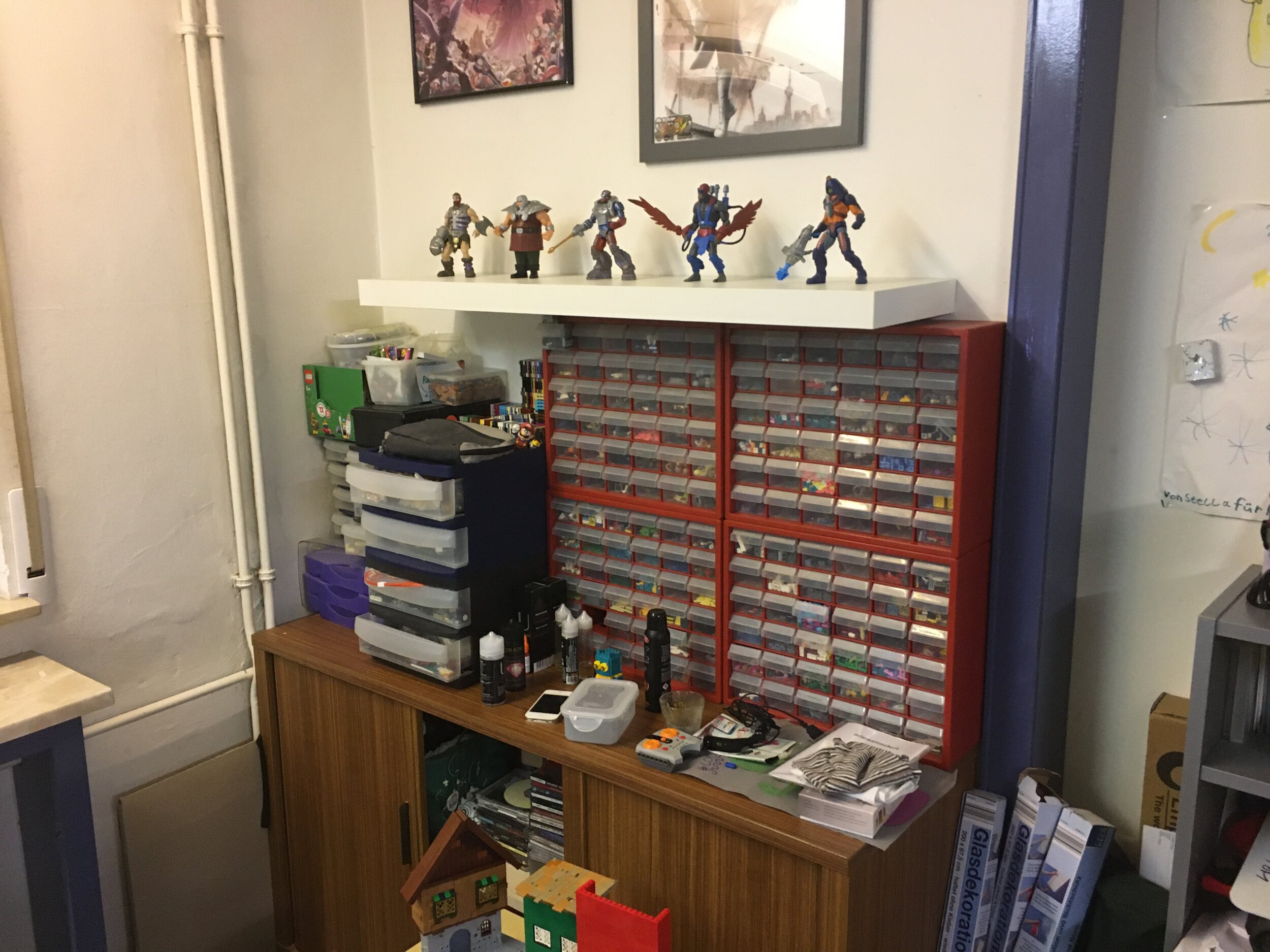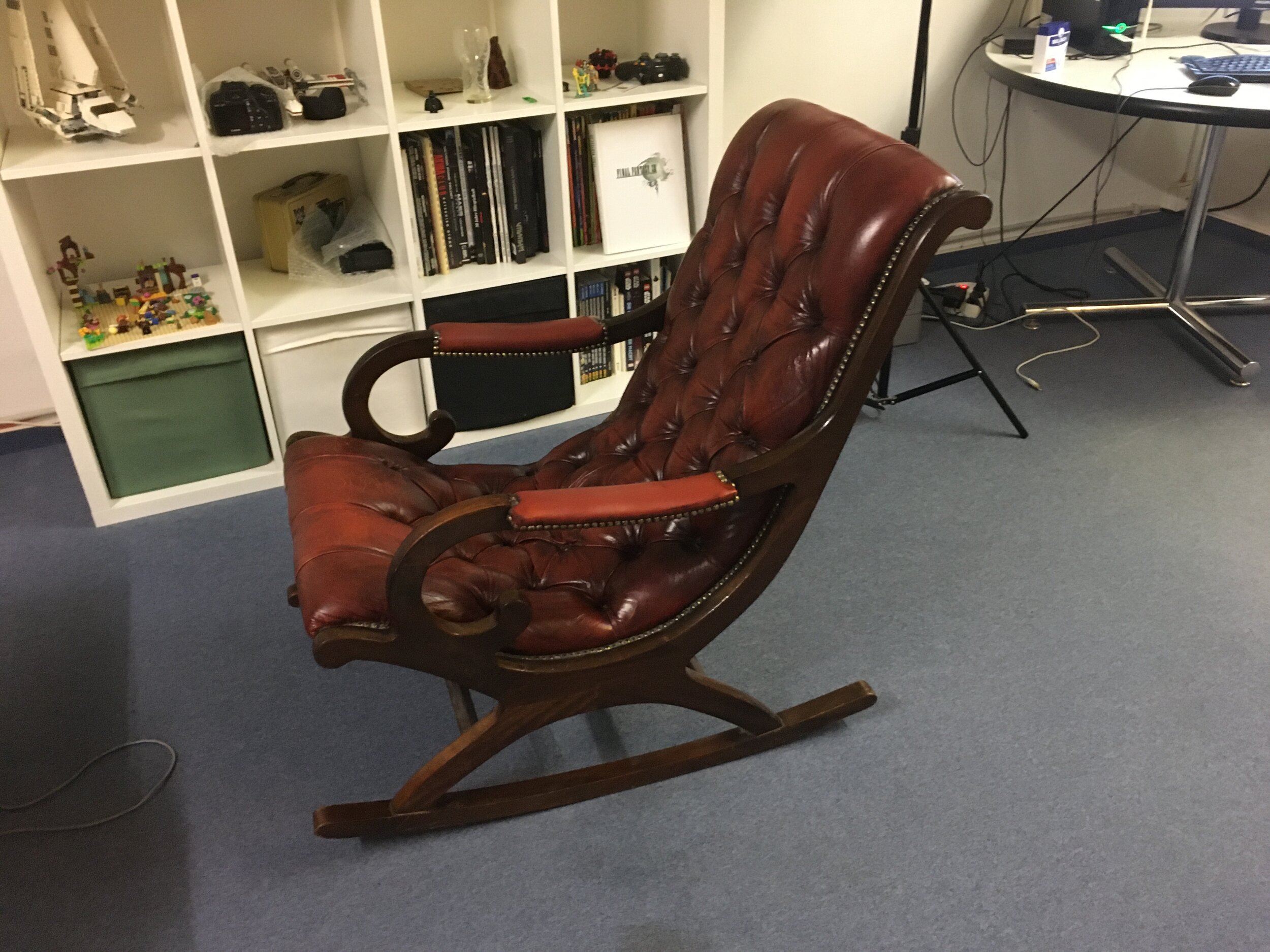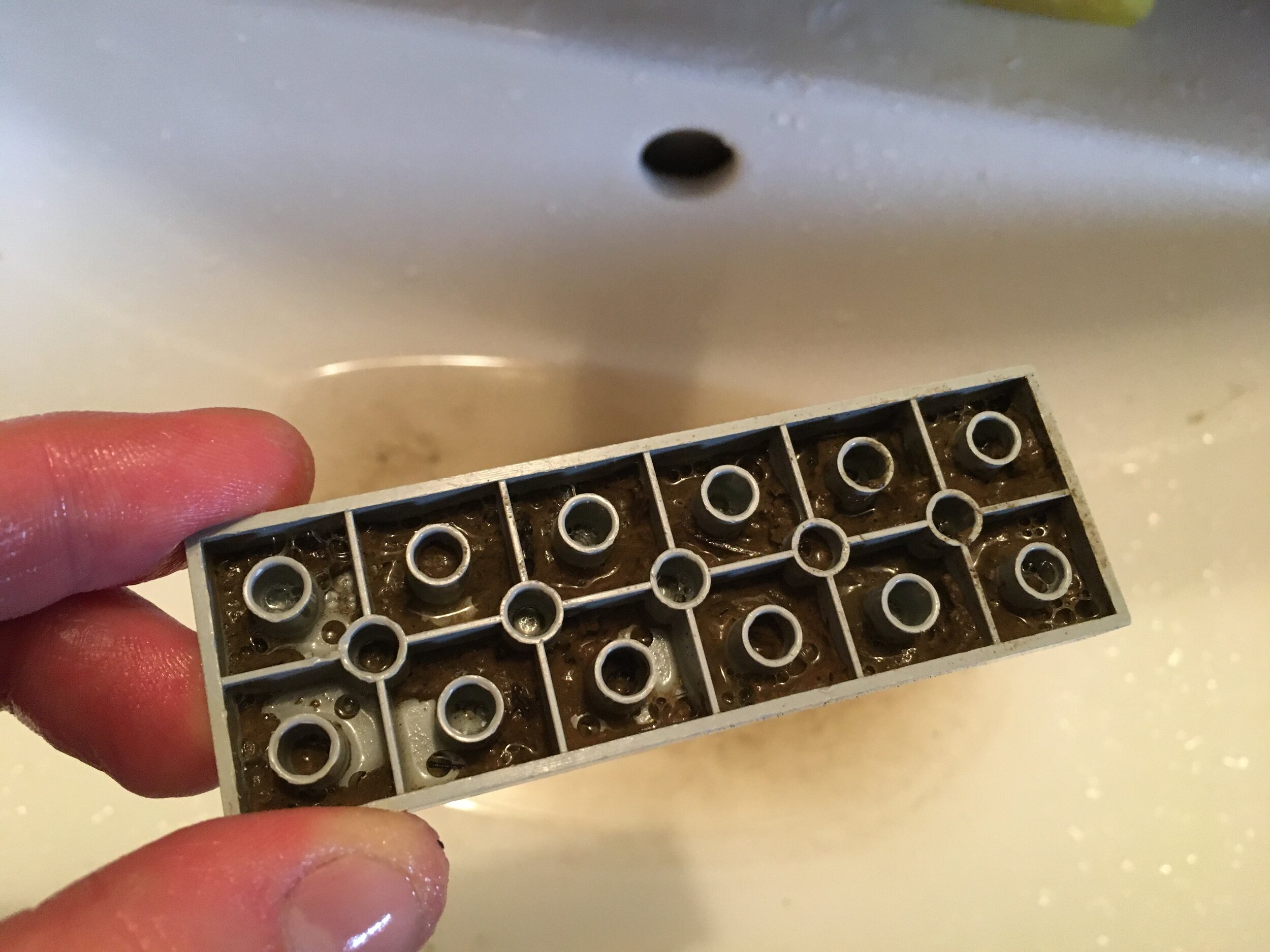After the Flood: Recovering Your LEGO Collection From Mud and Water
/Today’s guest article comes from “Fletcher Floyd” who was affected by the recent disastrous flooding in Germany. He shares his experience of recovering what he could of his LEGO collection after the flood, what to expect when cleaning mud off of LEGO, and what storage solutions either helped or hindered when it came to water damage.
This story originally appeared in German on the Rogue Bricks forum and has been translated and republished here with permission.
Fletcher’s Flood
For a while “Apoca” was a popular theme in MOCs – but what does it look like when your very own LEGO collection gets hit by the apocalypse? I experienced this exact scenario and as a result have written this little report.
For context, my family and I were affected by the flood in Germany’s Ahr Valley but were very lucky compared to others. The fire brigade evacuated us early and our apartment was barely full. But the basement was submerged – and with it (in addition to household and leisure equipment and other things) my LEGO collection.
I would like to make one thing clear in advance: what has happened here has never happened before. We are a flood region, yes, but what came over us was an angry tidal wave over seven meters high that simply carried everything away. Many people have died here, families and livelihoods have been destroyed, entire streets have disappeared. The day after, I stood in the puddles and saw cars upside down on the walls of houses. The damage of that night will be seen for years to come.
Image of the flooded region by The Associated Press.
It may seem strange, maybe even tasteless to one or the other, to do a kind of photo story about “mud LEGO” – as if there were no other problems than “luxury toys.” But, after moving to relatives (because there is no electricity, water, gas, internet), securing the bare essentials and a week’s worth of bucket-chains with many great helpers, you arrive at that moment where nothing is left to do that you can do by yourself. You simply have to wait a few days for others to do their work before you can take the next step.
And so when all the mud had been scooped out, all the forms had been filled out, and the brain and muscles were all mushy, I had time to kill for a few days. And what is there to do that somehow makes sense in a situation like this, where you live with your parents again and are sitting on a pile of muddy, stinking LEGO sludge? Well, obviously, you clean up all the stuff (your godmother doesn’t want it sitting on her beloved terrace for weeks) – and, while you’re at it, turn the experience into something useful!
In this case, “something useful” is possibly an experience report. I just wanted to take it as positively as possible and thought to myself, “When do you ever have direct insight into a flooded LEGO collection?” There may be many opportunities here to clarify long-unanswered questions and to dispel myths and legends in the areas of stability, cleaning, shelf-life and safe storage. Let me tell you this: I was surprised by a lot of things!
The Calm Before the Flood
I was able to move into this basement about eight years ago. It was already set up, hence the worn carpet and the rather antique-looking large shelf. It was a mixture of office, gaming room and LEGO. Ironically, I finally wanted to redesign the room – new floor, paint, other furniture (apart from the amazing rocking chair, of course) – but unfortunately that was then taken care of by said tidal wave.



A Basement Full of Water
This is what it looked like for two days before the THW (a federal relief agency) approached with a special pump:
A Bucket Chain with LEGO Bricks
When most of the water was sucked out, this sight remained:
Now, I was able to go on a hand-fishing tour for the first time. This answered a long-standing question, namely that of the toughest LEGO Castle faction. The question has been clarified once and for all: The blue falcon knights are the undisputed winners – here is the proof:
Whenever possible, the many heroic helpers who helped us scoop mud for days after my first inspection, occasionally also fished some LEGO out of the mud. This resulted in numerous containers full of LEGO bricks that had been completely clogged with sludge.
Cleaning Muddy LEGO
This muddy LEGO now had to be cleaned. Mama Floyd was invaluable in helping with this. It should be noted here that the mud wasn’t the only problem. Because of countless leaked oil tanks in the floodwater, all the bricks also exhibited a rather penetrating gasoline slick that had to be removed in any case. And so it quickly became clear: simply giving it a wash wasn’t going to be enough.
Initially, it was about getting the coarsest mud off the LEGO and getting rid of the smell. We first put each pile in a bucket with washing powder and stirred well. Parts of sets or walls were initially left in one piece and roughly scrubbed off with a brush.
In a second bucket, it was then submerged into rinse with detergent then again with fresh water for a final rinse. The first batch was then put into pillowcases and run through the laundry machine, but at some point, we departed from that and switched to doing the final wash by hand.
One major problem we faced was that the sludge had also gotten in-between connected bricks. Basically every single brick had to be cleaned again individually even after the final wash, as there was always residue left over that couldn’t be cleaned completely.
A simple toothbrush proved to be particularly handy, at least in the case of cleaning the shallower parts up to the height of a brick. All taller pieces represented an extra challenge that I have not yet devoted myself to (more on this in the last section). Here you can see a brick-height element before and after cleaning it with a toothbrush:
I am far from finished with this final washing cycle – and don’t underestimate this step. Just cleaning this single brick in the picture above took over a minute before everything was gone. The sludge got in every single opening.
As a (albeit wrongfully eternally unsuccessful) Brickfilm maker, my minifigures were naturally the first in line to be cleaned:
But even after, there are many parts that still have some muck on them. By the way, head or hat molds, especially made of softer material (such as Queen Amidala’s headdress), can easily drive you crazy because you can only tell after drying it off whether everything is really gone. Another tip: Always move minifigure legs to a backwards position when cleaning them. There’s often some remains underneath the hips, and in the worst case, also inside the legs. Having fun with LEGO is definitely something completely different. This operation here is just a really annoying and painstaking amount of work.
And so you start each of these toothbrushing sessions very diligently, doing really good work for about an hour. And then you notice how suddenly your back is aching, and you see the pile of dirty parts that is still in front of you… and then you just rinse the remaining stuff in the bucket of clean water again, and then at some point and think to yourself, “That’s enough for now—the remainder will get taken care of when I need the part again.”
First Damage Report
After everything had been pretreated, the time came to create a first damage report.
Some sets and parts disappeared completely in the flood, including:
10193 Medieval Marketplace (at least I still have the cows)
Second latest freight train
Parts of the Lone Ranger train
Two Power Functions motors including controls
Most of the train tracks
Box full of roller coaster track
All building instructions
Various sealed Star Wars polybags
All tiles (except white)
All decorated tiles
All slopes in light and dark gray (goodbye brick-built rock faces/mountains)
All trans-clear-blue studs and tiles (goodbye tiled water)
All studs (with and without holes)
All small plants
Half of my leaves (lavender, dark red, dark orange – of all my favorite colors)
A sorting case full of small parts
Another sorting case full of weapons and accessories of all kinds (clubs, spears, swords, muskets, blasters, throwing stars, knives, keys, wands, etc.)
All of the small animals (birds, dogs, cats, chickens, pigs, etc.)
The sails of all my ships (including the Black Pearl and Queen Anne’s Revenge)
My complete WIP for the Summer Joust Collab category (approx. 60% finished)
Almost all hair pieces, beards, and neckwear of my minifigs
Also helmets and shields from special themes such as Lord of the Rings / Hobbit / Pirates / Falcon Knights / Lion Knights, etc.
Various vehicles from the LEGO City range
Boxes of special sets that I had saved, such as Helm’s Deep, Mill Village Raid, Medieval Marketplace, Queen Anne’s Revenge, Exo Suit, Ecto 1 and DeLorean
In addition, all the sets that I still had in the original packaging were soaked, and while I was able to save the bags, things like the cardboard boxes, instructions, and some stickers sheets are no longer usable.
Etc. (I haven’t recorded everything yet since it starts getting annoying very quickly)
At least I was able to completely assemble this formerly mint racing car, and even the stickers made it on the vehicle without any losses, despite the formation of wrinkles and some stains (mud at least comes off well):
Looks pretty good so far, but I was still able to find some dirty areas or spots I had missed during cleaning:
I don’t want to cry. Sure it’s a shame about the losses, but most of the stuff could actually be saved somehow. I can clean a lot of the built sets and many bags with assorted colors (even if affected by the water). To be clear: I still have a lot of LEGO. And some things I was able to save and carried upstairs. But about 3/4ths of the remaining collection took a swim in oily mud for two days. I wouldn’t want to sell that to anyone.
In the case of collectable minifigures, unfortunately, only very little is really complete. My sometimes somewhat idiosyncratic storage of accessories has turned out to be both a curse and a blessing. I still have my two Roman legionaries – but without the helmets, shields and spears. I still have the torsos and legs of my three elven hunters, but no shields, longbows, heads or hairpieces.
At least the most important box for me personally didn’t vanish. All my skin-tone heads, torsos and legs were still there. If they had disappeared, I probably would have given up. Buying all of this again I couldn’t have stomached financially. So this was “Fletchers Deciding Tub.”
And with finding that tub, at least some motivation came back. I’ve already ordered a small stock of hair pieces and accessories off of BrickLink again, but of course, you can’t compare it with what I used to have.
Final Insights
Now for the most interesting part, here are some insights into safe storage and cleaning of LEGO after a flood.
1. Does water get into sealed LEGO bags?
Unfortunately yes! However, it rarely destroys the bags. So open them and wash the contents, completely write off any previously existing collector’s value and just enjoy the rescued bricks. :)
2. Which containers protect the best against water?
It sounds unbelievable, but these plastic cookie jars have proven to be the involuntary “test winners.”
It’s true that dirty water has gotten into these, too, but actually only very little. Even the sticker sheets that I had stored in one of these boxes are still usable (albeit minimally damp).
Furthermore in retrospect, I am glad to have put many completely assembled licensed minifigures in cellophane bags. A little water tends to get in, but the bags mostly floated on the top and were easy to find and collect. In fact, almost all my Star Wars characters have reappeared and all my Pirates of the Caribbean minifigures, too. Especially with the latter, I let out a big sigh of relief after recovering their container.
3. Which containers offer little to no protection?
Ikea boxes (like plastic tubs) without a fixed lid or clamps, i.e. only with a lid resting on them, have proven to be problematic. The lid simply lifts off and everything swims happily away. Cardboard boxes or cartons can’t be recommended either. With LEGO sets in their original packaging, you tend to have the advantage that the additional glue often prevents the box from completely disintegrating. As a result, it generally still contains the bags within – although the contents are course completely soaked, dirty and ruined along with the instructions (stickers are always 50/50).
The yellow LEGO storage boxes with studs hardly performed any better, as these can only be closed at the side. As a result – similar to the Ikea boxes – they naturally don’t do well under water (neither of which are designed for that, obviously). Basically, proper side locks or clasps are mandatory for me from now on.
The organizing drawers (like Akro-Mills) that are popular with most of us (including me) have unfortunately turned out to be an absolute nightmare. Pretty much everything has disappeared from them. The small open drawers swam away and the contents are gone. Usually the smaller elements are stored there. I suspect most of them were sucked off by the technical emergency service with the water pump.
4. Will stickers that have already been affixed survive cleaning?
In principle, yes. It’s absolutely not recommended though, as the edges are clearly visible afterward:
Hand washing with only lukewarm or cold water does not have this unsightly effect!
5. How resilient is LEGO itself?
Here you have to give full marks as always. Nothing really broke. The product itself is still great (apart from reddish-brown, of course ;-) ).
6. what about fabric like capes or sails?
Here I experienced a surprise. Even the dirty fabric capes will probably be usable again in a pleasantly high percentage after they have been cleaned a second time (not all of the white ones will make it though). For sails, I can’t report anything since mine are all gone. :-(
7. Does the water or the cleaning process damage printed bricks and minifigures?
Yes and no. With intensive brushing, prints can fade or disappear. Nothing should happen with a toothbrush in lukewarm water though. Everything still looked good afterward.
8. So no issues at all?
In the end, it’s not that simple. The bricks still feel a bit “dull” even after three washes due to the prolonged time in the oily-brackish water. Every brick that I intend to use at some point has to be examined again individually and, if necessary, brushed off again. I imagine that will become a complete nuisance since you will have to wait until everything is dry – water stains don’t look good, and damp LEGO tends to develop a slight odor.
When manipulating the figures it is also noticeable that arms and legs of affected torsos or leg assemblies can no longer be rotated quite as smoothly.
9. Which parts are difficult or almost impossible to clean?
A cellophane bag of white slopes revealed some extreme cases. Anything that is taller than a brick (e.g. 1x2x3 slopes) that has dirt on the inside cannot be reached with a toothbrush. I’m planning to give cotton swabs a try and might report back. It’s a similar case for some headgear elements such as wizard hats. There’s still some dirt in those at the tip.
I hope you’ll find this report useful! If so it was at least worth the effort.
Fletcher wanted to reiterate that he didn’t write this report to receive pity or compassion; he just wanted to create an informative article to help people in a similar situation. For that effort, we thank him for sharing so openly and honestly, and we hope that this helpful LEGO flood-recovery guidance is used as infrequently as possible!
Best of BrickNerd - Article originally published August 16, 2021.
Have you ever had to clean mud off of LEGO? What worked for you? Leave your thoughts in the comments below.
Do you want to help BrickNerd continue publishing articles like this one? Become a top patron like Marc & Liz Puleo, Paige Mueller, Rob Klingberg from Brickstuff, John & Joshua Hanlon from Beyond the Brick, Megan Lum, Andy Price, Lukas Kurth from StoneWars, Wayne Tyler, Dan Church, and Roxanne Baxter to show your support, get early access, exclusive swag and more.



































